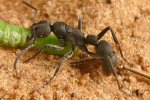 



Weather data
A large number of automatic weather stations has been implemented in the frame of the BIOTA AFRICA project by the Namibian National Botanical Research Institute (NBRI) and the Group "Biodiversity, Evolution and Ecology" (BEE) of the University of Hamburg. The website offers hourly updates of data and graphs of a large number of weather parameters.

|
Animal diversity It is a main aim of BIOTA AFRICA to make data which are obtained and analysed by the different disciplines available to other subprojects as well as to other researchers, organisations, and institutions world wide that have a bona fide interest in the information. The accessibility of data is an important precondition for fruitful co-operation and for the effective use of data processed by BIOTA AFRICA.
Amphibians Kakamega Forest

|
In total, 24 amphibian species are known from Kakamega Forest, Western Kenya. They belong to the families Bufonidae (2 spp.), Dicroglossidae (1 sp.), Arthroleptidae (2 spp.), Hyperoliidae (8 spp.), Ranidae (1 sp.), Pipidae (1 sp.), Phrynobatrachidae (3 spp.), Pyxicephalidae (1 sp.), and Ptychadenidae (5 spp.).
During the BIOTA project, one frog species (Leptopelis mackay Köhler et al. 2006) was new described. The species is endemic to Kakamega Forest and its vicinities. Two species represent new records for Kakamega Forest.
Details
|
Reptiles Kakamega Forest

|
In total, 61 reptile species are known from Kakamega Forest, Western Kenya. These include 1 turtle species (Pelomedusidae), 24 lizards (Agamidae, 3 spp.; Chamaeleonidae, 5 spp.; Cordylidae, 1 sp.; Gekkonidae, 4 spp.; Lacertidae, 2 spp.; Scincidae, 8 spp.; Varanidae, 1 sp.) and 36 snakes (Atractaspididae, 1 sp.; Colubridae, 23 spp.; Elapidae, 4 spp.; Typhlopidae, 2 spp.; Viperidae, 6 spp.).
During the BIOTA project one agamid species (Agama finchi Böhme et al. 2005) was new described from the vicinities of Kakamega Forest.
Details
|
Birds Kakamega Forest

|
Kakamega Forest is a hotspot of bird diversity in Eastern Africa and has been assigned an Important Bird Area by BirdLife International. In Kakamega, almost 500 bird species have been recorded of which 10% are found nowhere else in Kenya. Kakamega Forest harbours important extant populations of two globally threatened species: Turner's Eremomela (Eremomela turneri) and Chapin's Flycatcher (Muscicapa lendu).
Details
|
Dragonflies Kakamega Forest

|
A total of 72 dragonfly species, representing 42 % of Kenya’s dragonfly fauna, has been recorded from Kakamega Forest. They represent by the families Aeshnidae (7 spp.), Calopterygidae (2 spp.), Chlorocyphidae (4 spp.), Coenagrionidae (11 spp.), Corduliidae (2 spp.), Gomphidae (10 spp.), Lestidae (2 spp.), Libellulidae (33 spp.), and Protoneuridae (1 sp.). Three of these are based on literature records only (Phyllomacromia kimminsi, Neurogomphus pinheyi, and Paragomphus alluaudi). The habitat preference and affiliation with other African regions is listed for all species. The dragonfly fauna of the Kakamega Forest is impoverished compared to more western Guineo-Congolian rain forest areas.
Twenty species are of national importance for Kenya, since they are only found at this site within the country.
Details
|
Bees Kakamega Forest

|
In total, about 242 bee species are known from Kakamega Forest and the surrounding agricultural areas in Western Kenya. Some of the species still need to be confirmed. They belong to the families Apidae (~92), Halictidae (~76), Megachilidae (~72), Colletidae (~6). Before the BIOTA- investigations, only 24 bee species were known for the area. Thus, most of the species are new records for the area.
Details
|
Butterflies Kakamega Forest

|
The following list reflects the current state of research into Kakamega's Lepidoptera. Well known are butterflies with 487 species (this is more than a half of all butterfly species occurring in Kenya), although there is a lack of biological information for many species.
Details
|
Fruit flies Kakamega Forest

|
A total of 137 species of Tephritidae are recognized from Kakamega Forest and the surrounding area of which at least 25 (18%) are undescribed, or were so when this study began. These species represent 14 tribes and 59 genera from the four subfamilies of Tephritidae. Over half of these species are Tephritinae, most of which breed in flowers.
Details
|
Ants Kakamega Forest

|
The presented species list is based on material collected in the Kakamega Forest between 1999 and 2009 and deposited in the collections of the Zoological Research Museum Koenig, Bonn, the Natural History Museum of Los Angeles County, Los Angeles, and the National Museums of Kenya, Nairobi.
The examined material was sampled using different sampling methods in all habitats of the Kakamega Forest.
Details
|
|
|






 Go to the WeatherNet
Go to the WeatherNet





